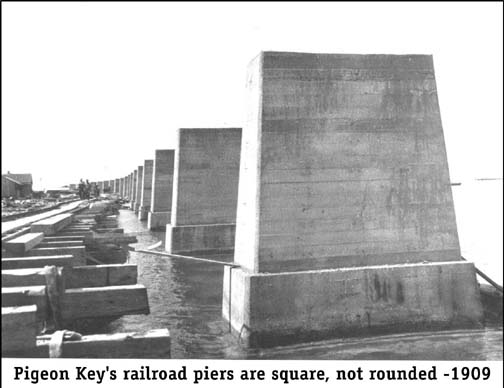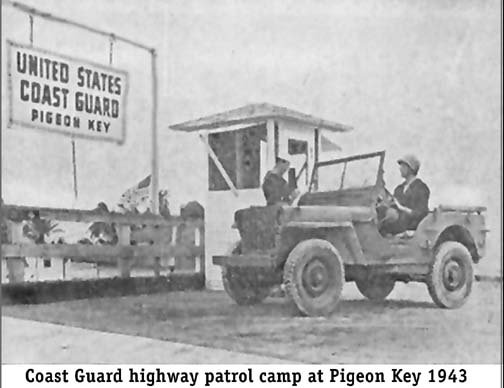|
HISTORY
OF
By Jerry Wilkinson |
 |
|
HISTORY
OF
By Jerry Wilkinson |
 |
|
From an article in the Indianapolis Sunday Star dated January
21,
1912, one gets a glimpse at life on Pigeon Key from one who was there.
I have no idea when the writer was on Pigeon Key, but the article's
date
is the day before Henry Flagler made his first trip to Key West.
Anyway, quoting from the last part: "The [railroad construction] camps are in charge of a resident or division engineer with the one at Pigeon Key presently the most active. At high tide Pigeon Key is about two acres in extent and perhaps three acres at low tide. There are four bunkhouses, each designed to hold 64 men; one of them for the foremen, who are housed apart from the laborers. Each has a reading room with good lights. Good mattresses are provided on standard double-decked bunks, with plenty of clean bedclothes; all laundry work being done by the company. Once a week all beds are washed and thoroughly disinfected to keep any parasites from getting a start. "The engineering and office force are housed in a combination office and sleeping quarters. All buildings are erected securely on pilings and well braced to keep them from blowing away. [They had learned their lesson from the 1906, 1909, and 1910 hurricanes.] Numerous tents are provided but are not nearly so satisfactory. These tents are set up over wooden framework and are numbered the same as houses in a city; and the "Bo" who is facetious, if nothing else, has named the spaces between, Fifth Avenue, Thirty Third Street, Broadway names reminding them of their home city. [Earlier in the article the author stated: "By far the greater number of laborers are "hobo's" recruited by labor agencies in New York and Philadelphia. . ., therefore Bo is probably short for hobo.] "The cooking and food supply is under supervision of a steward. The "Chuck" is clean and wholesome, but very little of the knick-knack variety is furnished. Beefsteak, beef roasted and beef in the famous "Mulligan" style is furnished in abundance. Plenty of ham, bacon, peas, sweet and Irish potatoes, pumpkins, tomatoes and apples are always on hand. "Strict discipline as to cleanliness are enforced, and all debris must be thrown into the tide, where it is washed away. A watchman patrols the camp to see that this rule is enforced. Most of the camps have walks laid out, coursed by walls of coral rock and conch shells. Between these the ground is kept well smoothed and in some instances flower gardens are in sight." Pigeon Key was known as Cayo Paloma (dove or pigeon) on early Spanish charts. Most believe it was probably named after the Keys white-crowned pigeon. There was little use of the 5.31-acre island until Henry Flagler needed it to complete the Seven Mile Bridge. The bridge was then known as "Knight's Key-Pigeon Key-Moser Channel-Pacet Channel Bridge." Moser Channel was where the swing bridge was and Pacet Channel the southern end which is of arch construction. The work on the island had begun before chief construction engineer Joseph Meredith died on April 30, 1909 and William J. Krome took over. Almost a year earlier, resident engineer C. S. Coe sent Meredith the following letter dated July 31, 1908: "The island is rather small for a large camp but with careful arrangement of space it will be possible to establish a very comfortable camp with space for the warehouse and a small material yard." The original design contemplated the portion at Pigeon Key to be another rock-filled causeway. This is evidenced by the two concrete abutments off both ends of the island. The water is shallow enough, but bridging was the option taken. Another oddity in F.E.C. construction is that the concrete bridge piers at Pigeon Key have squared corners. All other F.E.C. Railway piers have rounded corners. With the completion of the railroad to Key West in 1912, Pigeon Key changed from a construction camp as described by the Indianapolis Sun article to a bridge tender-maintenance camp. Some buildings were dismantled and new ones built -primarily homes plus a commissary for a more stationary work force. World War I passed rather uneventfully on Pigeon Key except for a search light on the Moser Channel Bridge. A school was opened in 1923 in an attempt to attract and keep more married personnel. Dorothy Tribble and Edith McCommom were the early teachers. A post office was also established on April 9, 1923 and remained open until September 5, 1933. From May 1923 to March, 1927, the Pigeon Key post office also served the Marathon area, as its post office was closed. Chronologically, the next major Keys incident was the Great Hurricane of 1935 that destroyed much of the railroad in the Upper Keys. Of the WW I veterans building the Upper Keys bridge to eliminate the need for car ferries, 253 were known missing. Pigeon Key, relatively unaffected by the storm, became the southern base for rescue, relief and evacuation operations. It is a long story, but the F.E.C. sold its entire right-of-way, including Pigeon Key in its entirety, to the State for $640,000 on November 9, 1936. The newly created Overseas Toll and Bridge District issued contracts and converted the right-of-way into the Overseas Highway without any ferries. Pigeon Key was the Headquarters for this enormous task. So enter the second era of the saga of Pigeon Key. The highway was opened in 1938 and remained a toll road until 1954. All this time it was under the direction of personnel at Pigeon Key, who had a few problems. The yearly tolls were in excess of a million dollars. During WW-II the Coast Guard had a recruit training camp at Marathon. In 1943, the Coast Guard took over Pigeon Key and Pirates Cove Fishing Camp as barracks to house personnel patrolling the highway. The Navy operated the pipeline and the Coast Guard guarded the highway.  In 1954, the Miami News reported that a saltwater swimming pool
was built at taxpayer expense, however was labeled "private." Then it
was
revealed that there were $45,258 of food purchases in one year
including
steaks, shrimp, frog legs and dressed rabbit. Then a so-called work
boat,
a "sizable cruiser. . .equipped with fishing chairs, out-riggers and
flying
bridge", was revealed as part of the work equipment. This led to the
demise
of the second era.
In 1954, the Miami News reported that a saltwater swimming pool
was built at taxpayer expense, however was labeled "private." Then it
was
revealed that there were $45,258 of food purchases in one year
including
steaks, shrimp, frog legs and dressed rabbit. Then a so-called work
boat,
a "sizable cruiser. . .equipped with fishing chairs, out-riggers and
flying
bridge", was revealed as part of the work equipment. This led to the
demise
of the second era.
On April 15, 1954 the tolls were removed and later the Toll District was officially dissolved. Almost ceremoniously, the tollbooths were hauled away. The well-meaning Lt. Governor renamed the highway the "The Florida Freeway." Locals protested and the Florida Freeway signs were removed. Land title was transferred to Monroe County on September 4, 1954. Hurricane Donna visited Pigeon Key in 1960 and two buildings were so damaged that they were burned. A few years later, in need of a hands-on marine biology center, the University of Miami leased the island for a project designed by Dr. Gilbert Voss. It canceled the lease one-month short of expiration in 1987, citing high cost of operation. The present Seven Mile Bridge was dedicated in 1982. It bypassed Pigeon Key completely. Before 1982, the bridge did not actually span seven miles of continuous water. So ended another era. Associated with Pigeon Key was the Moser Channel bridge which is where the channel opening is now -the one where part of the movie True Lies was filmed. The original railroad swing-bridge was widened to accommodate vehicles in the 1936-38 conversion program. The converted bridge had a clearance of 15-feet three-inches. On March 3, 1981, a 15-foot nine-inch back hoe being transported struck a propane tank suspended below the bridge tenders cabin. The tank exploded killing 39 year old Peter Flancher of Big Pine Key. Construction of the concrete Seven Mile Bridge was in progress, but with the control system destroyed, the old bridge could not be opened for maritime traffic required by the Coast Guard. After much bureaucratic discussion, it was decided to give the $286,000 repair estimate as overtime to speed up completion of the new bridge. Various colleges rented the facilities on a short-term basis. The 1986 Comprehensive Land Use Plan zoned Pigeon Key as OS which means "off shore island." This basically translates to: not much can be done on Pigeon Key. There are about 800 other keys zoned OS awaiting precedent to be set by Pigeon Key. In 1988, Monroe County authorized the Pigeon Key Advisory Board. After much study, the board was dissolved in 1991. In the meantime, Pigeon Key was designated a historic district in the National Register of Historic Places in 1990 and included in the Monroe County Historical Register. The proposed Comprehensive Land Use Plan has the zoning designation changed to recreation. As Walter Cronkite would have said, "And that is how it was." Return to Specific Locations, Keys, Communities |
